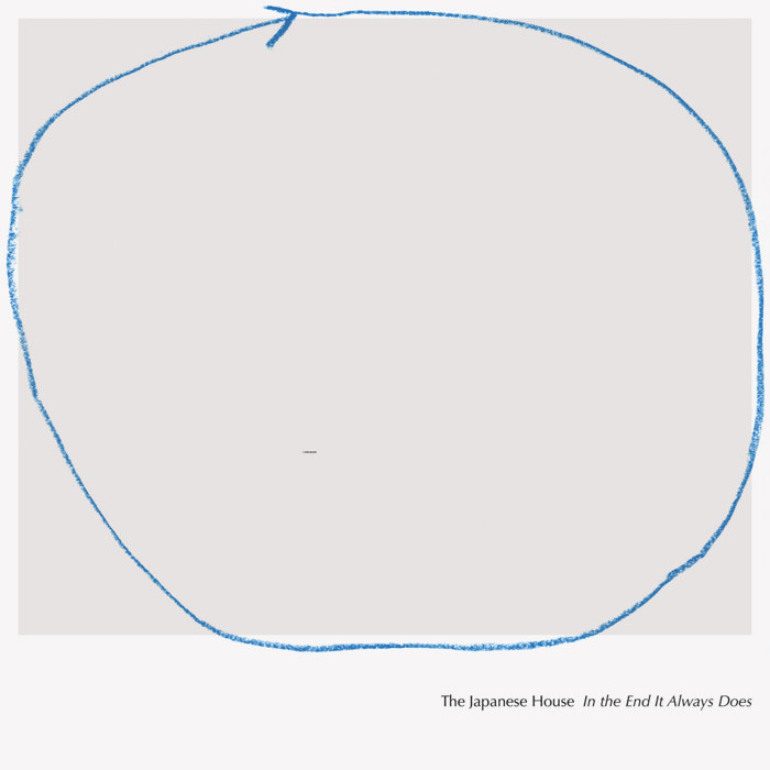

A Thoughtful Tapestry of Tangible Sorrows
Amber Bain, known to most as The Japanese House, dropped In The End It Always Does this summer; the heat of the sun felt in most areas of the world during time of year is comparable to the fiery vision Bain is striving to get across in this sophomore album. Each track on the album morbidly celebrates, but doesn’t glorify, the ideals and complexities of heartbreak, loneliness, crackling love — and hold in store emotionally charged meditations on the lingering trauma of events that transpired in Bain’s childhood. All’s on the table for the taking with this collection of songs, as it seamlessly elevates itself to become gorgeous pop music, through the nitty-gritty of painful expression.
Those who make the journey to Bain’s music may notice the album’s cover art, a sloppy circle which looks as if it could’ve been drawn on a napkin by a drunken man at a bar or perhaps by a preschooler making their first attempt at whatever their young mind thinks art to be. There’s more significance to the design than one might first suppose, however. That would be because In The End It Always Does is meant to evoke contradiction. Endings and beginnings, compassion and antipathy, falling in love, then out of it — all of that’s placed on a pedestal of sorts through the imperfect circular portrait. Bain’s intentions turn transparent; she’s tending to the tailored tales of traumatic experiences she’s gone through, urging all listeners to hop on this roller-coaster composed of tracks that lack pristine tranquility. Instead, they thrive on discordant harmonies that seek to explore the broadest difficulties of agony.
In The End It Always Does wouldn’t be what it is without those who witnessed all its growth, including Matty Healy and George Daniel of The 1975 and prominent producer and engineer Chloe Kraemer. Formidable forces at her side, Bain was blessed with piles of creativity to extract something out of, and the result isn’t lackluster. Her inspiration glows throughout, and it’s hard to miss the simultaneously colossal and baffling curveball it is.
Several tracks triumph as connectors. “Touching Yourself,” one of the sexier but sadder entries on the album, breaks down the ballistic-leaning nature of certain romantic relationships and is actively searching for the chaos that comes as soon as persistent desire and healthy heartbreak arrive face to face with each other. Bain sings, “And when you call me, I’m all over the place now/You think it’s different, but it’s the same,” eloquently playing around with her intended meaning. Is she trying to connect all back to the everlasting circular motion that’s pictured on the album’s cover and also sought after throughout, or is she merely using the song’s title and its lyrics to insult a past lover of hers who excited her but also trashed her heart? The answer, while unclear, is meaningful because there isn’t an exact one. On the contrary, her willingness to leave her work up for interpretation helps listeners to understand her comfortability as a singer-songwriter.
Bain’s not forgetful. She released “One for sorrow, two for Joni Jones” as a single around the beginning of June and uses it as the closer for In The End It Always Does. The track nicely caps all off like a juicy cherry atop a sundae. It sparkles with a flourishing piano, and in four minutes marches its way toward safe havens of melancholy. If the album’s cover is to be recalled for just another moment, then it must become crucial to note how this doleful body of verses brings everything back to the genesis of it all, since it utilizes a single drumbeat to create an endless loop. That’s Bain’s pain: something to be lived through over and over, whether that’s what’s desired or not. She has made that the foreground of her work and the end product is a bowl of bits of lonely lamentations.
